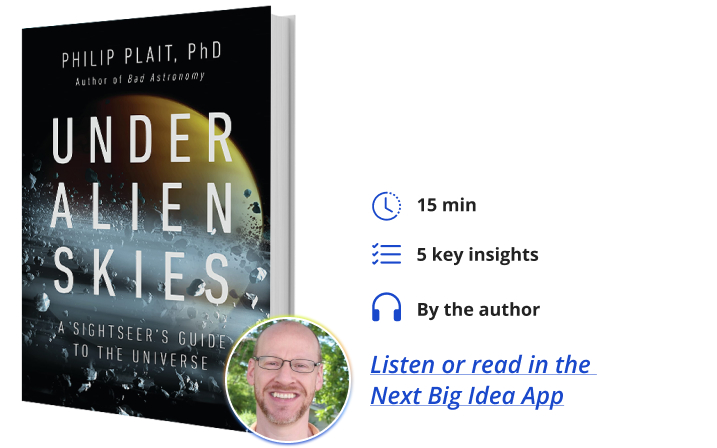Phil Plait, also known as the Bad Astronomer, is an astronomer, writer, and science communicator. Plait has worked as part of the Hubble Space Telescope team, as well as engaging in public outreach advocacy for NASA missions.
Below, Phil shares five key insights from his new book, Under Alien Skies: A Sightseer’s Guide to the Universe. Listen to the audio version—read by Phil himself—in the Next Big Idea App.

1. What would all those fantastic objects we see in telescopic photos look like if you were there?
We humans have a natural sense of wonder, and a natural appreciation of artistic beauty. Where better to satiate both than astronomy? The sky is filled with staggering beauty, from the stars themselves, to multicolored gas clouds, to immense galaxies like our own Milky Way. Just seeing photos of these from telescopes is an amazing experience.
When you understand what you’re seeing, it opens up a new dimension of appreciation. How do stars form? Why does Saturn have rings? What happens if you fall into a black hole? We can answer all of these questions through science.
But what would all this look like if you were there? It’s a very common question—as an astronomer it’s one I’m asked all the time. Would they look like the photos we see?
Imagine standing in an eons-old dry lake bed on Mars, watching as a huge dust storm approaches, feeling it rumbling through your spacesuit’s boots. Or sitting outside in a chair on a warm spring day when suddenly the temperature drops because one of the two suns in your sky is eclipsing the other? Or lying back on the Moon, staring in awe at your magnificent blue-green home world as you watch a solar eclipse from the other side? What would that be like?
2. We forget that these other-wordly places exist; they’re real.
It’s an odd thing to have to say out loud, but when you look up at the Moon, or see Mars as a glowing red dot in the sky, it’s easy to forget that those are worlds, as real as the one you’re standing on.
It’s even easier to lose that sense when it comes to more esoteric things like black holes, gigantic gas clouds floating in space, or planets orbiting twin suns. You usually only see those in photos, or drawings, or in TV shows and movies, where you’re already in the mindset that you’re seeing something fictional.
“It’s even easier to lose that sense when it comes to more esoteric things like black holes, gigantic gas clouds floating in space, or planets orbiting twin suns.”
But all of those places are quite real. We’ve detected black holes all over the sky. Gas clouds like the Orion Nebula are huge factories cranking out stars. Our sun was very likely born in just such a place, billions of years ago. Planets orbiting around binary stars? We’ve found them! In fact, we know of quite a few planets where you’d see two suns in the sky instead of one. Imagine what being there would be like!
3. We have a lot of local color.
In our own solar system, you can travel to various worlds that orbit the Sun with science. You can go to the Moon, and Mars, visit an asteroid and a comet, see Saturn’s rings up close, and stand on the surface of frigid Pluto.
We’ve seen all these places up close and for real with space probes, and what we’ve found has always surprised us. For example, did you know that a lot of small asteroids, ones under roughly a mile across, aren’t solid? They’re more like bags of rocks held together by their own very weak gravity, what astronomers call rubble piles. They’re so fragile that if you tried to stand on one there’s a decent chance you’d fall right through the surface, like trying to stand on a big box full of packing peanuts! That almost happened with one of our space probes.
“Did you know that a lot of small asteroids, ones under roughly a mile across, aren’t solid?”
Saturn, with its spectacular rings, astonishingly diverse array of moons, and the planet itself being a giant gas bag, is my favorite world. Besides Earth, of course. The rings are incredible, filled with strange features that at first seem to defy logic, but ultimately are the product of the laws of physics. That doesn’t detract from their strangeness and beauty: trillions of small chunks of nearly pure water ice arranged in a flat disk literally thinner than a piece of paper to scale, all orbiting a planet that dwarfs Earth. What would that look like from a spaceship sailing a few miles above them? It would be amazing.
4. Even the weirdest places are understandable.
If there’s a weirder place in the Universe than a black hole, I haven’t heard of it. Space and time get bent, twisted, fed back into themselves, and that’s just outside a black hole. Inside one, our very notions of what space and time mean become useless.
As bizarre as all that is, we can, fundamentally, understand black holes. It takes a little bit of math and physics to truly grasp it all, but we can at least describe those effects. We can also predict what we’d see if we were foolish enough to get near one; or fall in one, even if what you experience would be like living through the last 20 minutes of 2001: A Space Odyssey.
“We can predict what a world would be like if it orbited a tiny, feeble, cool red dwarf star instead of our own Sun, and even take a stab at what weather would be like there.”
Our knowledge of the Universe is based on observing it, teasing out its rules, and then using those rules to predict how it behaves. And it works! We call this method “science” and it’s one of the most successful things humans have ever invented. We can know the cosmos. That means we can know what it would be like to ply through the ethereally thin gas inside a star-forming nebula or stand on a planet slack-jawed in awe as a million stars shine overhead. We can predict what a world would be like if it orbited a tiny, feeble, cool red dwarf star instead of our own Sun, and even take a stab at what weather would be like there.
And even better? It helps us understand our own world even more.
5. The Earth is unique-ish.
We know of only one planet like Earth in the entire Universe, and it’s not for lack of looking. We’ve discovered over 5,000 alien worlds, called exoplanets, around other stars, and while a few may be about the same size as Earth, or be around the same temperature, we still don’t know if any of these is truly Earth-like.
Just given the sheer number of planets—they probably outnumber the stars in our galaxy, so hundreds of billions at least—there must be some like Earth. Even then, though, they won’t be exactly like home, with the same ratio of oxygen in the air, the right amount of water, and just the right chemical balance in the soil, such that we’d feel perfectly at home there. That itself is a profound insight.
T. S. Eliot wrote, “We shall not cease from exploration
And the end of all our exploring
Will be to arrive where we started
And know the place for the first time.”
That is the best synopsis of why we study the heavens I’ve ever heard. The more we study other worlds, other locales, and other places in the Universe, the more we’ll appreciate our own home. We think we know what we have under our own sky, but the only way to truly appreciate it is to know what it’s like under alien skies.
To listen to the audio version read by author Phil Plait, download the Next Big Idea App today:
































